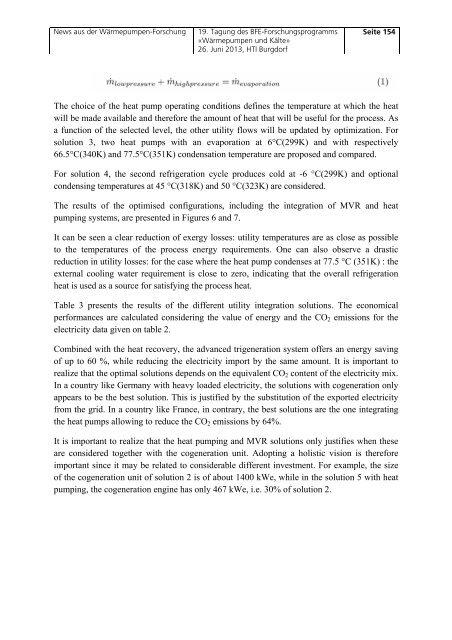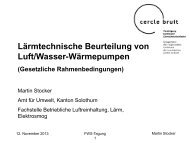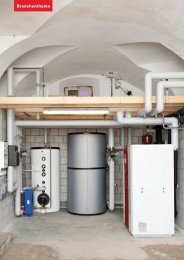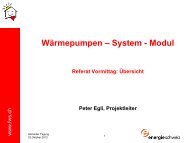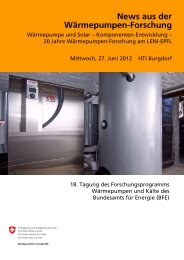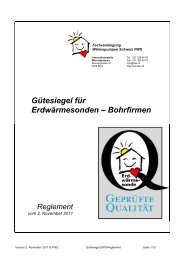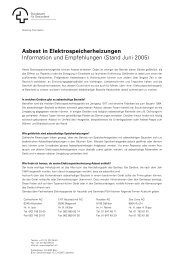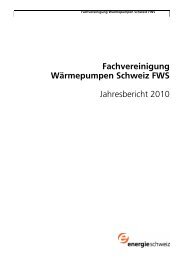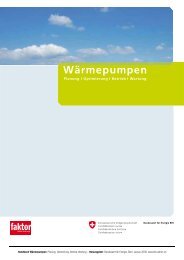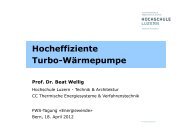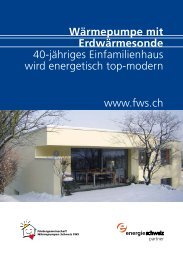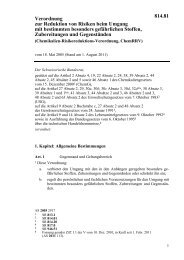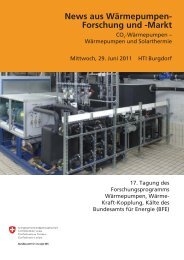Download - Fachvereinigung Wärmepumpen Schweiz FWS
Download - Fachvereinigung Wärmepumpen Schweiz FWS
Download - Fachvereinigung Wärmepumpen Schweiz FWS
Erfolgreiche ePaper selbst erstellen
Machen Sie aus Ihren PDF Publikationen ein blätterbares Flipbook mit unserer einzigartigen Google optimierten e-Paper Software.
News aus der <strong>Wärmepumpen</strong>-Forschung<br />
19. Tagung des BFE-Forschungsprogramms<br />
«<strong>Wärmepumpen</strong> und Kälte»<br />
26. Juni 2013, HTI Burgdorf<br />
Seite 154<br />
The choice of the heat pump operating conditions defines the temperature at which the heat<br />
will be made available and therefore the amount of heat that will be useful for the process. As<br />
a function of the selected level, the other utility flows will be updated by optimization. For<br />
solution 3, two heat pumps with an evaporation at 6°C(299K) and with respectively<br />
66.5°C(340K) and 77.5°C(351K) condensation temperature are proposed and compared.<br />
For solution 4, the second refrigeration cycle produces cold at -6 °C(299K) and optional<br />
condensing temperatures at 45 °C(318K) and 50 °C(323K) are considered.<br />
The results of the optimised configurations, including the integration of MVR and heat<br />
pumping systems, are presented in Figures 6 and 7.<br />
It can be seen a clear reduction of exergy losses: utility temperatures are as close as possible<br />
to the temperatures of the process energy requirements. One can also observe a drastic<br />
reduction in utility losses: for the case where the heat pump condenses at 77.5 °C (351K) : the<br />
external cooling water requirement is close to zero, indicating that the overall refrigeration<br />
heat is used as a source for satisfying the process heat.<br />
Table 3 presents the results of the different utility integration solutions. The economical<br />
performances are calculated considering the value of energy and the CO 2 emissions for the<br />
electricity data given on table 2.<br />
Combined with the heat recovery, the advanced trigeneration system offers an energy saving<br />
of up to 60 %, while reducing the electricity import by the same amount. It is important to<br />
realize that the optimal solutions depends on the equivalent CO 2 content of the electricity mix.<br />
In a country like Germany with heavy loaded electricity, the solutions with cogeneration only<br />
appears to be the best solution. This is justified by the substitution of the exported electricity<br />
from the grid. In a country like France, in contrary, the best solutions are the one integrating<br />
the heat pumps allowing to reduce the CO 2 emissions by 64%.<br />
It is important to realize that the heat pumping and MVR solutions only justifies when these<br />
are considered together with the cogeneration unit. Adopting a holistic vision is therefore<br />
important since it may be related to considerable different investment. For example, the size<br />
of the cogeneration unit of solution 2 is of about 1400 kWe, while in the solution 5 with heat<br />
pumping, the cogeneration engine has only 467 kWe, i.e. 30% of solution 2.


